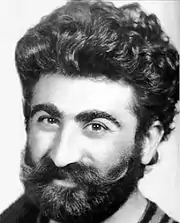Tatul Krpeyan
Tatul Krpeyan (Armenian: Թաթուլ Կրպեյան; 21 April 1965 – 30 April 1991) was an Armenian commander. He was the self-appointed leader of paramilitary units in Getashen and Martunashen villages in Shahumyan Region of Soviet Azerbaijan during the First Nagorno-Karabakh War. He was killed during Operation Ring by the Soviet Azerbaijani OMON (special police).[1]
Tatul Krpeyan | |
|---|---|
 | |
| Nickname(s) | Գետաշենի արծիվ (Getasheni artsiv, "Eagle of Getashen") |
| Born | 21 April 1965 Areg, Armenian SSR, Soviet Union |
| Died | 30 April 1991 (aged 26) Getashen, Soviet Azerbaijan |
| Allegiance | Armenian Revolutionary Federation[1] |
| Years of service | 1990–1991 |
| Battles/wars | |
| Awards | National Hero of Armenia (1996)[2] |
Biography
Born in the village of Areg near the town of Talin, Armenia, he completed his elementary and intermediary education in the Technical School of Talin. After serving in the Soviet Army, in 1987 he entered the Faculty of History of Yerevan State University. In his first year at the university, Tatul joined the Armenian-liberation movement. He was also a member of the "Miatsum" (Unification) organization, whose efforts were directed to unite Nagorno-Karabakh Autonomous Oblast with Armenia.
Operation Ring
In September 1990, he traveled to Nagorno-Karabakh, where the situation continued to deteriorate. Joining the Armenian Revolutionary Federation, Tatul founded the "Dashnaktsakanner" unit of volunteers in Karabakh.
He headed the self-defense of the sub-district Getashen-Martunashen from September 1990 until late April 1991 against Azerbaijani armed forces units and police detachments (OMON). Krpeyan was killed on 30 April 1991 in Getashen during Operation Ring. He received the highest title in Armenia, the National Hero of Armenia award in 1996. He was buried in Areg, which was later renamed after him – Tatul. A tuffaceous monument has been erected in memory of Tatul. The sculptor of the monument is Tariel Hakobian. In the spring of 1991 the main battleground of the partisan war was the wooded hills to the north of Nagorno-Karabakh where fighters from Armenia infiltrated to Armenian inhabited villages. Tatul Krpeyan led his people to Getashen and Martunashen. On 10 April 1991 the decision was made by the authorities to start operations against these villages.
The Moscow-based human rights group Memorial has reconstructed what happened. On 30 April 1991, 4th Army soldiers and then the Azerbaijani OMON entered Getashen near Shahumian, where Krpeyan was killed, and his people took several soldiers hostage. The OMON raided and looted houses and attacked many of the inhabitants. The dozen or so killed were in their eighties and nineties.[1]
I remember Tatul well. He was like a ‘fedayi’ (freedom fighter) from Sasoun - broad-shouldered, with curly hair and a thick moustache. Not only did he serve as head of the detachment but he also taught in the local school there. The role he played wasn't limited to just fighting…[3]
Legacy
Many works of art have been dedicated to Krpeyan. In 2004 Rafayel Sahakian has published a fictional documentary book named Artsvapasht Yerkir (Eagle-idolizing land), dedicated to him. The song "Leran Lanjin" ("Piedmont") was composed by Nersik Ispiryan. "Mayramut Ijav" ("At Sunset") was composed by Ashusgh Gevorg, as well as Ashot Babayan's sonata for cello and piano in 1993, were all reportedly dedicated to Tatul Krpeyan's memory.
In 2015, on his 50th birthday a school[4] and a park[5] in Yerevan were named in his honor. Stamps depicting Krpeyan were issued.[6]
References
- de Waal, Thomas (2013). Black Garden: Armenia and Azerbaijan Through Peace and War (2nd (revised and updated) ed.). NYU Press. p. 116.
- "State awards of the Republic of Armenia". Defence Ministry of the Republic of Armenia.
- Harmik Hovsepyan - Fighter from Shushi Battalion
- "Թիվ 62-րդ դպրոցը կկրի Թաթուլ Կրպեյանի անունը". Lragir.am. Retrieved 19 May 2016.
- "Մայրաքաղաքում բացվել է Թաթուլ Կրպեյանի անվան զբոսայգին". Retrieved 2 September 2015.
- "Մեկ նամականիշով բացիկ` նվիրված Թաթուլ Կրպեյանի 50-ամյակին". haypost. Retrieved 29 October 2015.